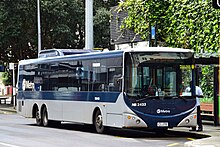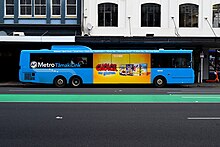NZ Bus
 From Wikipedia - Reading time: 9 min
From Wikipedia - Reading time: 9 min
 Logo used from 2005-2023 | |
| Formerly | Stagecoach New Zealand |
|---|---|
| Company type | Private |
| Industry | Public transport |
| Founded | October 1992 |
| Founder | Stagecoach Group |
| Defunct | 2023 |
| Owner | Kinetic Group |
| Website | www.wearekinetic.com |
NZ Bus was a New Zealand bus company, operating in Auckland, Tauranga and Wellington. Originally a subsidiary of Stagecoach Group, and formerly Infratil and Next Capital, as of 2022 it is owned and operated by Kinetic Group. It was merged with Kinetic's other NZ subsidiary, Go Bus Transport, in 2023 to create Kinetic Urban NZ.
History
[edit]
In October 1992 Stagecoach purchased Wellington City Transport (WCT), the largest bus-operator in Wellington, from Wellington City Council with 270 buses.[1][2] WCT had recently purchased the Auckland, Hutt Valley and north Wellington suburban bus operations of New Zealand Railways Road Services, then branded CityLine.
Stagecoach expanded its Auckland operations in 1998 by purchasing Transportation Auckland Corporation (trading as The Yellow Bus Company) from the Auckland Regional Council with 538 buses.[3][4][5]
in November 2005 Infratil purchased the business.[6][7] As part of the deal, Infratil had the right to use the "Stagecoach" name and livery for five years from the sale.[8][9]
In January 2008 the company bought Whangārei school and charter business Adams Travelines (later rebranded as NorthBus), which has since won the tender to provide the urban bus service for Whangārei as Citylink Whangarei, using super-low-floor buses. In May 2013 NorthBus was sold to Ritchies Transport.[10]
In April 2016 NZ Bus announced that it would repower several buses with Wrightspeed gas-turbine hybrid powertrains.[11] In February 2017 NZ Bus announced it would begin the trial of a BYD K9 electric bus in Auckland and Wellington.[12]
In 2018 NZ Bus planned to reduce the size of its Wellington operations from 73% to 28% of the city's bus routes following a re-tender; many bus-route services passed to Tranzit Group.[13]
In September 2019, Infratil sold NZ Bus to Australian equity buyers Next Capital for A$218–240 million, including a vendor loan of A$20–30 million.[14] At the time of the sale, NZ Bus operated 720 buses and had 1,400 staff.[15][16] In March 2022, the business was purchased by the Kinetic Group, and rebranded as Kinetic Urban NZ.[17]
Company rebranding
[edit]


| Former name | Depots | New name | Notes |
|---|---|---|---|
| Stagecoach Auckland | North Shore Hibiscus Coast |
North Star | Rebranded on 4 December 2006. Blue and yellow livery. |
| Swanson | AT Metro | Rebranded in 2017, with the new Western Bus Network. Blue and silver with AT Metro logo livery. | |
| Auckland Central (City) Mt Roskill Panmure |
Metrolink | Rebranded on 12 October 2008. Blue and silver and grey livery. | |
| Auckland Central (City) | Link Buses | Red colour for City Link
Green colour for Inner Link Orange colour for Outer Link Blue colour for Tamaki Link | |
| Wiri | AT Metro | Rebranded on 16 February 2009. Silver livery, with multi-coloured patterns influenced by traditional Maori designs. Rebranded in 2016, with the new Southern Bus Network. Blue and silver with AT Metro logo livery. | |
| Stagecoach Wellington | Various | Go Wellington | Announced in November 2006. Operating since early 2007. Yellow and black livery. Rebranded from April 2018 as part of the new bus network for Metlink. Lime green blue and yellow with Metlink logo livery. |
| Cityline Hutt Valley | Various | Valley Flyer | Rebranded on 21 November 2007. Purple and yellow livery. |
From late 2015, plans called for all buses operated by NZ Bus in Auckland to gradually begin to appear in AT Metro colours as part of Auckland Transport's initiative to create one brand for the Auckland transport network. Link services continued to operate in their red, green and orange branding,[18] but with AT Metro logos and other symbols instead of Metrolink. Similarly, Wellington buses operated under contract to the regional council are now branded in Metlink livery, rather than in GO Wellington or Valley Flyer livery.[19]
Smart card ticketing
[edit]On 20 April 2008 NZ Bus confirmed that it would start using a new ticketing system to make bus travel quicker, easier and simpler for passengers in Wellington.[citation needed] The new system, called Snapper, builds on RFID technology embedded in cards or in portable devices such as USB sticks. Use of the system started on 4 April 2008, being piloted on Go Wellington bus route 17 over the following two months. The supplier of the technology is Korea Smart Card (established in 2003), a joint venture between Seoul Metropolitan Government and LG Group, which has introduced T-money to six major cities in Korea.
NZ Bus fitted out its Auckland fleet with Snapper-capable equipment in 2011, despite losing a contract to provide smart-card ticketing to all public transport services in the Auckland Region.[20] NZ Bus went ahead with their Snapper roll-out in Auckland despite no other public transport providers signing up for it. Auckland Transport rolled out their own smart-card ticketing system, the AT HOP card. All public transport operators in Auckland, including NZ Bus, were required by law to accept smart cards issued by Auckland Transport. NZ Bus suggested that their Snapper system would be able to accommodate Auckland Transport's smart cards.[citation needed]
By late 2013, the use of Snapper had completely phased out in Auckland. In Wellington and Whangārei,[citation needed] Snapper is the interim region-wide bus ticketing system for the Metlink network in Wellington.[21]
See also
[edit]References
[edit]- ^ Kiwi link Commercial Motor 22 October 1992 page 16
- ^ New Zealand Fleetline issue 215 June 1993 page 128
- ^ Stagecoach buys YBC Australasian Bus & Coach September 1998 page 56
- ^ Stagecoach snaps up Yellow Bus Truck & Bus Transportation October 1998 page 89
- ^ Auckland Transit Australia November 1998 page 259
- ^ Disposal of New Zealand Operations Archived 5 December 2014 at the Wayback Machine Stagecoach 21 November 2005
- ^ Stagecoach sells New Zealand unit Archived 20 August 2017 at the Wayback Machine BBC News 21 November 2005
- ^ NZ operations go in £100m sell-off On Stage issue 61 January 2006 page 12
- ^ Stagecaoch New Zealand Australian Bus Panorama issue 21/5 March 2006 pages 11–15
- ^ Bocapa. "NZ Bus News". www.nzbus.co.nz. Archived from the original on 12 April 2017. Retrieved 9 July 2017.
- ^ New Zealand Adopts Wrightspeed Jet And Battery Power For Buses Archived 25 September 2017 at the Wayback Machine, Forbes 2016-04-22, viewed 22 May 2016
- ^ Bocapa. "NZ Bus News". www.nzbus.co.nz. Archived from the original on 6 July 2017. Retrieved 9 July 2017.
- ^ Infratil' NZ Bus concludes Wellington negotiations Archived 16 June 2018 at the Wayback Machine National Business Review 25 January 2018
- ^ NZ Bus Archived 25 April 2021 at the Wayback Machine Next Capital
- ^ "Infratil sells NZ Bus to private equity buyers". Stuff.co.nz. 24 December 2018. Archived from the original on 24 December 2018. Retrieved 24 December 2018.
- ^ World News Buses Worldwide issue 213 April 2019 page 62
- ^ Cotter, Fabian (11 March 2022). "Kinetic to acquire NZ Bus Ltd". Australasian Bus & Coach. Archived from the original on 12 March 2022. Retrieved 17 March 2022.
- ^ "Link Bus Service". Retrieved 12 June 2024.
- ^ George, Damian (6 April 2018). "From 'Wellington yellow' to 'vomitron green' – capital's new buses aren't everyone's cup of tea". The Dominion Post. Fairfax NZ. Archived from the original on 18 August 2018. Retrieved 18 August 2018.
- ^ "To enter Auckland market in 2010, targets Rugby World Cup for comprehensive integrated ticketing". Snapper. Archived from the original on 27 May 2010. Retrieved 13 January 2014.
- ^ "A summary of the upcoming changes to fares in the Greater Wellington Region". Snapper Services Ltd. Archived from the original on 18 August 2018. Retrieved 18 August 2018.
 KSF
KSF